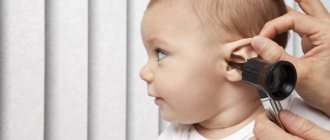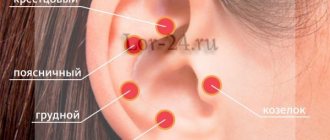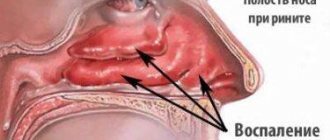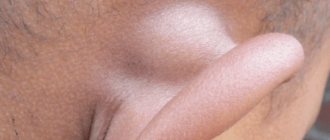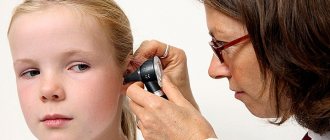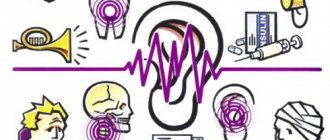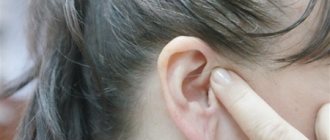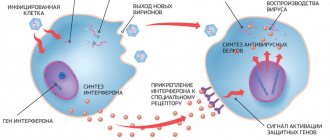The appearance of an unpleasant, itchy sensation in the ears is a fairly common problem that anyone can encounter. The presence of natural itching, which occurs due to the accumulation of sulfur, is allowed. In this case, increased discomfort occurs after taking a bath, due to the fact that water enters the ear, thereby softening the wax masses.
To get rid of these sensations, it is enough to maintain hygiene - clean and wash the ear canal more often. But there are situations in which unpleasant itching persists for a longer time. This is when a trip to an otolaryngologist is necessary.
In such circumstances, itching is a symptom of a disease that can have a very negative impact on the health of the hearing aid. In addition to this symptom, others may appear, for example, purulent discharge, congestion, peeling of the ear canals, fever and even hearing loss.
Severe itching in the ears is an indicator of systemic diseases that form in the body. If it occurs rarely and there is no discomfort, this symptom can be easily ignored. However, we should not forget that psoriasis, otitis media, eczema and dermatitis most often begin to manifest themselves as just such a symptom.
In addition to diseases, itching in the ears can occur due to mechanical damage to the ear canal by any foreign object, for example, a cotton swab. This happens due to sulfur getting into the resulting microtraumas.
Causes of itching in the ears
The main reasons that cause itching in the ears include:
- abundant accumulation of sulfur mass;
- irritation of unknown origin;
- elderly age;
- intense hair growth in the ear opening;
- increased dryness;
- injuries;
- hypothermia of the whole body;
- allergic reaction;
- otitis caused by microorganisms;
- skin diseases of the outer ear;
- diabetes;
- the appearance of a boil in the ear canal;
- metabolic failure;
- ear mite
Activation of pathogenic microorganisms that become active due to severe hypothermia may also occur.
An inflammatory process in the ear, which is characterized by an acute or chronic course - otitis media. The main symptoms of the disease are redness of the ear, pain and burning, severe itching. Penetration of pathogenic microflora occurs from the nasopharynx directly into the tympanic cavity. Passing through the Eustachian tube, they quickly penetrate the inner ear. In addition, it is possible from the external environment.
- A mild form of inflammation of the ear canal and concha is otitis externa. With this type, pain of a different nature appears (dull, pressing, sharp), which intensifies when trying to touch the ears. There is also weakening of hearing and the appearance of persistent low-grade fever.
- With inflammation of the middle ear, the auditory tube is damaged, and an accumulation of exudate in the tympanic cavity is observed. The patient suffers from ear congestion, decreased hearing acuity, fever, intoxication and severe pain. As soon as purulent discharge appears, pain decreases and well-being improves.
- Labyrinthitis is characterized by impaired hearing and balance. Vestibular disorders occur in the body, resulting in dizziness and loss of coordination. After this, hearing loss occurs, noise and severe itching occur. The pain intensifies when turning the head to the side.
Otomycosis
The development of the inflammatory process due to infection of the ear by a fungus occurs against the background of the development of chronic otitis media. Due to exposure to unfavorable factors, there is an increase in fungi of the genus Candida, which are normal inhabitants of the skin. In this case, severe itching, white flakes of skin, and a whitish crust appear in the outer ear. In severe forms of the disease, fungi can penetrate deeper, affecting not only the labyrinth, but also the bones of the skull.
Allergy
An allergic reaction can develop to a large number of products from the food, industrial and cosmetic industries. In most cases, allergies are accompanied by itching in the ears. In this case, treatment is coordinated between two specialists - an otolaryngologist and an allergist.
Skin diseases
Since the appearance of itching in the ears is considered one of the first symptoms of the development of skin diseases, if this symptom develops, the development of ear dermatitis can be suspected. This disease is characterized by itching of varying intensity, redness, and the formation of nodules.
With eczematous dermatitis, in addition to itching, severe peeling appears, as well as hyperemia of the skin, on which small blisters are located.
If the outer ear is damaged by pathogenic fungi, seborrheic dermatitis develops. In addition to the characteristic plaques, greasy yellow spots appear on the skin.
Mechanical damage
Damage to the ear canal can occur due to improper cleaning of the ears, which results in microtraumas. It is into these small lesions that an infection can penetrate and begin to spread to neighboring organs.
In rare cases, an insect may enter the ear, which will also cause itching and discomfort.
Causes of heat in the ears
Besides the fact that when there is a burning sensation in the ear, it can not only be unpleasant, but also m
The reasons for this can be both external and internal problems.
At the first manifestations of any kind of pain or discomfort in the ear organ, you should immediately begin actions aimed at preventing the possible development of the disease.
If the inside of the ears is hot, the reasons lie in many factors. Most often, this feeling can be accompanied by itching and swelling, as well as redness of the skin. If the pain inside the ear is sharp and cutting, this may indicate that an infection has entered the ear and, possibly, an inflammatory effect has begun.
Our body is designed in such a way that many organs in it are interconnected. This applies in particular to the head. Almost everything that happens in the ears is somehow connected with the head. If a painful sensation in the form of a burning sensation in the ears radiates to the back of the head, then most likely the cause of this is problems with blood vessels. If high blood pressure is added to this, then symptoms will include tinnitus and pulsating sensations in the back of the head.
In addition to these reasons, there is another one that occurs quite often, namely excessive accumulation of wax in the ears. This can happen due to improper or untimely cleaning of the ear canal. It is worth remembering that you need to be very careful when cleaning your ear canal, and especially your child’s.
Use only high-quality ear cotton swabs for this.
Under no circumstances use any improvised material such as pins or matches to clean your ears.
Inaccurate movements while cleaning the ears can damage the ear canal, which in the future can lead to the development of an inflammatory process.
The best way to clean your ears most efficiently and effectively is to use hydrogen peroxide. It should be noted that it is better not to clean your ears yourself, but ask a loved one to help you.
Continuing to consider the reasons that may cause a burning sensation in the ears, it is worth mentioning external irritants.
If you listen to music on headphones frequently and for long periods of time, wear earrings made of a material to which you may be allergic, or wear a hat that sits tightly on your head, squeezing your earlobes. Also, a feeling of itching and heat in the ear canal can be caused by the penetration of some insect into the auricle.
Another factor that can cause your ears to feel hot may be increased brain activity. With increased stress on any organ of our body, it begins to require additional energy.
So, if we consider mental load, then our brain will need the maximum amount of energy to work effectively. In this case, the blood is directed to the brain and because of this, the face, neck and ears may turn red. This process sometimes causes an unpleasant burning sensation in the ear canal.
If you experience an unpleasant feeling of heat in only one organ of hearing, while periodically you hear extraneous noises, pops and other extraneous sounds inside the ear, this is
There are a lot of reasons for this. From sulfur plugs and mechanical damage to congenital pathologies and development against the background of respiratory diseases, colds or flu.
At the first symptoms of otitis media, you should immediately seek help from a medical facility to obtain the correct diagnosis and possible treatment options.
In addition to the fact that when there is a burning sensation in the ear, it can not only be unpleasant, but can also be a signal from the body about the presence of a pathological process.
Use only high-quality ear cotton swabs for this.
If you experience an unpleasant feeling of heat in only one organ of hearing, while periodically you hear extraneous noises, pops and other extraneous sounds inside the ear, this may signal that you are experiencing the first symptoms of otitis media.
Symptoms that may accompany itchy ears
With the addition of painful sensations, we can talk about the development of an inflammatory process in the ear cavity. In this case, a trip to a specialist is considered mandatory.
When a sore throat and itching in the ears are localized, we can talk about the development of a sore throat; these symptoms disappear immediately after treatment.
If, in addition to the main symptom, discharge appears, then this indicates the presence of a fungal infection.
The development of peeling is the main symptom of dermatitis, vitamin deficiency and allergies.
The formation of a boil, a purulent inflammation of the hair follicle, indicates the development of staphylococcus.
Itching in the ears: treatment
Therapy can be started only after a diagnosis has been established. In the future, complex treatment may be required:
- Use of medications: antibiotics in the form of drops are prescribed for the development of otitis media. If intoxication occurs in the body, then direct oral administration of antibiotics is prescribed. Drops that have an anti-inflammatory effect are also widely used. If atomycosis develops, an antimycotic drug is prescribed. The development of an allergic reaction is an indication for the use of antihistamines.
- Physiotherapy. In certain cases, warming up the ear canals is allowed, as well as washing and getting rid of sulfur masses.
- Traditional medicine methods are also widely used in the fight against itchy ears. But do not forget that first of all you need to get advice from a specialist. The following have proven themselves to be excellent: tea tree oil, salicylic alcohol, calendula tincture, propolis alcohol tincture.
In order to avoid the development of itching in the ears, it is necessary to maintain careful personal hygiene, avoid hypothermia and increase the overall immunity of the body.
Itchy ears, itching in the ears - these symptoms are familiar to many. And this is one of the most common problems with which patients turn to an otolaryngologist. A natural cause of itching is the accumulation of wax in the ear canal. After bathing, the itching intensifies. This is due to the penetration of water into the ear and softening of the wax masses. Simple hygiene procedures - cleaning or washing your ears - will help you get rid of this problem. But it happens that the ear continues to itch. Itching in the ears becomes a symptom of a disease that requires serious treatment. Against its background, other clinical signs may appear: the appearance of purulent discharge, pain, discomfort and congestion in the ears, peeling, dizziness, fever, incoordination of movements, and hearing loss.
Intense itching in the ears is an indicator of systemic diseases of the body. Itching itself is not a disease. If it appears rarely and does not cause discomfort, then you can ignore it. But it should be remembered that such serious illnesses as psoriasis, dermatitis, eczema, otitis media and many others can begin with itching.
Ears may itch in individuals with increased individual sensitivity. Improper hygiene can cause excruciating itching. When the skin of the external auditory canal is injured with cotton swabs or other improvised means, sulfur penetrates into microtraumas, which manifests itself in discomfort and itching.
Burning in the ear: causes and treatment (8 photos)
Unpleasant sensations in the ear area can manifest themselves in different ways, but most often a sick person may notice a burning sensation. Under no circumstances should such complaints be left unattended, as this can lead to hearing loss in the future. If you experience a burning sensation in your ear, you should consult a doctor as soon as possible so that he can prescribe the correct treatment. It is important not only to eliminate the symptoms, but also to conduct a complete diagnosis, which will help determine further effective therapy. Why does burning occur?
There is not a single person who would disagree with the opinion that the normal state of the hearing organs should not include any unpleasant sensations in this area. If a person experiences pain, burning or congestion, he should consult a doctor as soon as possible to begin treatment. The fact is that all the symptoms that appear in a person indicate pathology. The causes of burning in the ear can be a consequence of the following diseases:
- The appearance of a boil.
- Otitis externa.
- Otomycosis can often develop.
- Cases of eczema are common.
- The burning sensation may be the result of an allergic reaction.
- It is impossible not to notice the symptoms of a burn or injury.
- Unpleasant sensations appear in the case of a tumor.
It should be noted that these are not all the reasons due to which such symptoms appear. For example, some systemic processes can also be provocateurs for the manifestation of a burning sensation in the ear. Such deviations include hormonal disorders that occur in the endocrine system. This can even lead to a person experiencing pain, a burning sensation in the ear, or even a lack of vitamins in the body or intoxication with harmful substances. To make an accurate diagnosis, you will need to see a doctor. Examination and diagnosis
Telling about your feelings will not be enough, since a thorough diagnosis is still required. The fact is that each disease will be accompanied by its own symptoms. It is on the basis of them and a complete diagnosis that the specialist will be able to make a diagnosis and prescribe treatment.
The initial examination by a doctor consists of the patient telling in detail what he feels and what worries him.
A professional can palpate and collect medical history. Each case has its own symptoms, so it’s worth getting to know them in more detail. Furuncle
If you carefully study the structure of the ear, you can see that in the very part of the ear canal there are follicles and sebaceous glands, which are often subject to purulent-necrotic inflammation. In medicine, such a case is called a “boil.” The symptoms that a patient may experience are as follows.
- There is a sharp pain.
- A constant burning sensation appears in the ear, especially intensifying when a person begins to chew food.
- The patient may notice a fever, headaches, and enlarged lymph nodes.
It is not difficult to determine the appearance of a boil, since a red elevation appears, in which purulent exudate collects in the center. In this case, it is important to consult a doctor, as pus can cause the infection to spread to other tissues. Otitis externa
Otitis externa is associated with microbial inflammation that can spread to the entire ear canal.
The symptoms of this disease depend on the form in which it occurs. For example, a strong burning sensation in the ear occurs in an acute form. If you press on the tragus, the person also feels a sharp pain. When the doctor conducts an examination, he discovers significant redness of the passage. The latter becomes swollen and covered with exudate. Often the damage reaches the tympanic membrane, which adds to tinnitus. Otomycosis
Otomycosis is a fungal infection. Often this disease is accompanied by permanent injuries, which lead to everything else and dermatitis. As a rule, otomycosis can be found not only in the ear canal, but also in the tympanic cavity. It is quite difficult to immediately identify the symptoms of the disease because it develops gradually. And only when it reaches enormous sizes, the patient begins to feel the following signs:
- First of all, you can notice a strong burning sensation in your ear, which is also accompanied by severe pain.
- There is a feeling of congestion and constant noise.
- Discharge begins from the ear.
Some patients consult a doctor because of severe headaches, which can occur on the same side on which the ear is damaged. As soon as the doctor conducts an examination, he will notice that yellow and sometimes even black contents have accumulated in the passage. Eczema and allergic reaction
Many people do not understand why a burning sensation in the neck and ear occurs at the same time.
Often, such symptoms may even indicate the development of eczema, which is localized in the ear canal. As a rule, the disease immediately begins to develop acutely, so it is almost impossible not to notice it. Eczema is a serious disease, which is additionally accompanied by a disruption of the bacterial flora, which increases inflammation and the release of pus. It is not uncommon for discomfort in the ear to occur due to allergies. For example, all symptoms are local in nature, the reaction occurs in the place where there was exposure to intolerant drugs. In this case, it cannot be said that the allergy poses a potential danger or threat to life, especially if the person was provided with the necessary first aid in a timely manner. Tumor, injury, burn
If a person gets injured, ear pain will be inevitable. This also allows us to determine the extent of the damage. For example, if there is a burning sensation in the left ear, the causes are most likely hidden in the damage on the left. There will be swelling of the soft tissues that completely block the ear canal. The situation with the right ear is also assessed if the injury was received on the right.
It should be noted that injuries and burns are very serious. And the doctor will not be able to carry out the diagnosis using a routine examination, since during a visual examination you can only see abrasions and bruises, so diagnosis is required using special devices. A specialist will be able to identify a tumor much faster and easier. The patient himself will be able to identify the presence of symptoms such as bloody discharge from the ear. As the tumor begins to grow, other diseases such as otitis media, mastoiditis and meningitis will develop in parallel. In order to start treatment in a timely manner, it is necessary to pay attention to such symptoms.
- Noise and significant hearing loss.
- Constant discharge begins from the ear.
- A person experiences frequent headaches.
- Lymph nodes enlarge.
- Added weakness and weight loss.
A tumor is a serious oncological process that can spread to the bones of the skull, affect the salivary glands and lymph nodes. Diagnosis
Only a doctor can determine the real causes of a burning sensation in the ear. In no case should you prescribe treatment yourself, as this can lead to serious complications. You should definitely consult a doctor who, using laboratory and instrumental methods, will conduct a diagnosis and be able to determine the correct treatment. A specialist can prescribe the following types of diagnostics:
- General analysis.
- Analysis of ear discharge.
- Strokes and prints.
- Allergy tests.
- Biopsy and histology.
For each person, examinations will be prescribed individually, it all depends on the pathologies and symptoms that the person experiences. Treatment
Every person must clearly understand that a complete recovery is only possible with proper and comprehensive therapy. Additional tests and studies may be needed if the patient begins to feel discomfort in order to determine the exact causes of the burning sensation in the ears. Only an ENT specialist can determine what disease he has. As a rule, the most used medications for treatment are different groups.
- If the disease is caused by bacteria, then antibiotics are prescribed.
- Antiseptics are used to treat wounds.
- Ear disease caused by fungi is treated with antifungal medications.
- To reduce the inflammatory process, anti-inflammatory drugs are useful.
- Doctors also often prescribe antihistamines and cytostatics.
The ENT specialist determines the nature of the disease in his patient.
For example, drops, ointments, and rinses may be used locally. If the disease is systemic in nature, then you need to take pills and injections. Electrophoresis, laser therapy and UHF can be an excellent addition to the treatment complex. Material taken: Here
Etiology
The main causes of itching in the ears:
- Overproduction and accumulation of wax in the ears,
- Irritation of the ear canal of unknown etiology,
- old age,
- Rapid hair growth in the ear canal,
- Dry ears
- Ear injuries
- General hypothermia of the body,
- Allergy,
- Otitis of microbial etiology,
- Skin diseases of the outer ear,
- Diabetes,
- Furuncle of the auditory canal,
- Metabolism disorders in the body,
- Ear mite.
With general hypothermia of the body, pathogenic microbes are activated and exert their pathogenic effects.
Acute or chronic infectious inflammation of the ear is manifested by itching, burning, pain and catarrhal syndrome, redness and swelling of the auricle. Pathogenic microbes usually penetrate into the tympanic cavity from the nasopharynx through the Eustachian tube, into the outer ear from the external environment.
- Otitis externa is the mildest form of inflammation that affects the ear canal and pinna. Patients experience acute, throbbing or dull, pressing pain in the ear, touching the ears becomes painful, hearing weakens, ringing, itching and discomfort appear in the ears, and persistent low-grade fever is possible.
- Otitis media is an inflammation of the middle ear caused by dysfunction of the auditory tube and the accumulation of exudate in the tympanic cavity. The pathology is manifested by ear congestion, hearing loss, autophony, fever, throbbing pain moving to the temple area and the crown of the head, and general symptoms of intoxication. When purulent discharge appears, the pain decreases and the patient’s well-being improves.
- Inner ear inflammation or labyrinthitis is a disease whose main symptoms are hearing and balance problems. Vestibular changes are the first signs of pathology, manifested by dizziness, imbalance and loss of coordination of movements. A day after vestibular disorders, patients experience hearing loss, noise and itching in the ears, worsening when turning the head, pain in the ear, especially with sudden movements, and deafness.
Colds are the main cause of tingling in the ears
Burning pain in the ears occurs especially often in autumn and winter. Wet and cold weather often causes painful circulation problems in the outer ear. In addition, exposure to cold strains the immune system, which increases the risk of diseases such as runny nose (rhinitis), flu and colds (also influenza infection). They affect all areas of the upper respiratory tract. Due to their proximity to the Eustachian tube, colds often penetrate into the ear, resulting in a burning sensation in the ears.
If a cold or flu is not treated properly during the course of the illness, there is also a risk of infectious agents entering the eustachian tube later on. As a result, swelling and inflammation initially occurs in the ventilation duct. The process of air exchange, as well as pressure equalization in the ear, is extremely difficult.
In addition to increased pressure in the area of the eardrum, such a violation of ventilation contributes to the development of effusion in the tympanic cavity. This is followed by an accumulation of secretions in the middle ear, which can quickly develop into a source of infection. If subsequent infection occurs in this manner, tingling in the ears is very likely. Common accompanying symptoms are cough, hoarseness and runny nose, depending on the previous cold. Depending on the severity of the infection, fever and chills may also occur.
Otomycosis
This is an inflammation of the ear of fungal etiology, developing against the background of chronic otitis media, failure to comply with personal hygiene rules, wearing a hearing aid, and damage to the skin of the ear canal. Fungi of the genus Candida are normal inhabitants of human skin and do not cause harm to the body. Under the influence of unfavorable exogenous and endogenous factors, their number increases sharply, and otomycosis develops. It is manifested by itching, white flaky discharge, and skin hyperemia. Over time, patients develop whitish crusts in the outer ear. In severe cases, fungi penetrate deep into the organ of hearing, affecting the labyrinth and even the bones of the skull.
Allergy
Allergic reactions often manifest as itching in the ears. Allergens include cosmetics, insect bites, latex swimming caps, the use of headphones, poplar fluff, and dandruff. The otolaryngologist, together with the allergist, will conduct a comprehensive examination of the patient, identify the allergen and prescribe appropriate treatment.
Itching in the ears due to allergies can appear occasionally or bother the patient constantly. It is a signal from the body about a serious disorder. With allergic dermatitis, a keratinized rash appears on the skin, the skin thickens and becomes denser. If the ears itch and burn at the same time, the patient may be allergic to a fungus.
Skin diseases
Itching in the ears is one of the first symptoms of dermatological pathologies. The delicate and sensitive skin of the ear canal with these ailments itches from the inside.
- Clinical signs of ear dermatitis can range from mild scratching to severe inflammation, manifested by unbearable itching in and around the ear, redness, and the formation of nodules that break open and leave behind oozing spots. Long-term pathology leads to hyperpigmentation and thickening of the upper layer of the epidermis.
- Symptoms of eczematous dermatitis are: intense itching, peeling and hyperemia of the skin, the appearance of small blisters covered with yellow and brown crusts.
- Seborrheic dermatitis develops as a result of infection of the skin of the outer ear by pathogenic fungi. The skin with seborrhea is irritated, covered with plaques and greasy yellow crusts. Seborrheic scales can be located inside the ear, around it, and down to the neck and cheeks.
- Psoriasis is a disease of unknown etiology, manifested by the appearance of red spots on the skin that peel and become covered with white scales. Persistent itching in the ears is one of the first signs of psoriasis. Redness, peeling of the skin of the ear canal and itching are unpleasant symptoms of the pathology, worsening the general well-being of the patient and leading him to depression. If the disease is not treated, the plaques gradually increase in size and spread deep into the ear canal, causing pain and tinnitus. The appearance of the plaques frightens others and instills in them the fear of infection.
Associated symptoms indicate the first signs
The reasons can be very varied. The symptoms are similar to otalgia. The combination of tingling in the ears with various accompanying symptoms often provides the first indication of possible triggers:
Tinnitus
The most harmless version of tingling in the ears is “ringing in the ears,” sometimes a sharp pain that occurs from a cold in the outer ear or earlobes. In this case, it may be due to a decrease in blood flow to the blood vessels of the ear.
Throbbing in the ears
If the burning occurs in combination with tapping or throbbing in the ears, it is usually a sign of severely narrowed blood vessels. In this case, the pressure in the vessel can literally be heard. In addition to the effects of a cold, this form may also be based on a blood pressure disorder associated with the disease.
Burning pain from pressure
There are many reasons that lead to changes in ear pressure. Various scenarios are possible, from sudden changes in altitude, such as those experienced when flying in an airplane, to blocked ears, from effusion in the tympanic cavity to problems with the ventilation of the eustachian tube (for example, in the case of inflammation associated with illness). Such pain when changing pressure is not always dangerous. However, if symptoms persist and do not go away, a doctor must diagnose these problems to keep the patient safe.
Burning sensation and difficulty swallowing
Difficulty swallowing, coupled with tingling in the ears, can also be caused by changes in hearing pressure. Otherwise, the accompanying complaint mainly occurs with colds, tonsillitis and throat infections. Other symptoms, such as coughing or throat congestion, are also possible with the underlying diseases mentioned, with a short-term increase in burning pain usually occurring during the process of swallowing.
This is explained by the proximity of the throat area to the eustachian tube and the involvement of swallowing in equalizing pressure in the ear. In the worst case scenario, painful swallowing problems indicate that the air duct is already affected by an infection related to the disease. Subsequent infection and inflammation of the middle ear cannot be ruled out due to an increase in the number of pathogens.
Burning in the ears and blockage of the airways
In addition to difficulty swallowing, stabbing ear pain in numerous ENT diseases also occurs along with a stuffy throat, nose, or blocked frontal sinus. There are common associated symptoms other than colds and flu, especially with sinus infections, including the frontal sinuses. These conditions are usually nothing to worry about if treated promptly. However, if left untreated, such diseases can spread far beyond the ear into the sensitive areas of the meninges and cause meningitis.
Burning in the ears, headache and dizziness
The inner ear is a key position, converting pressure waves into sound signals that ultimately reach the brain, and the balance organ is also present in the inner ear. It is located deep in the pyramid of the temporal bone, next to the cochlea of the inner ear. Since this part of the ear is involved in development, the symptom usually occurs along with corresponding accompanying complaints such as dizziness, balance problems or headache. In addition, skull fractures and meningitis can cause disturbances in perception and headaches. If in doubt, consult your doctor immediately if you have these combinations of symptoms.
Burning in the ears combined with hearing problems
In addition to the tingling sensation, a cold can also cause hearing problems such as tinnitus. The cause can range from trauma to the eardrum due to a rupture, to trauma from an impact, as well as extreme damage to other noise-processing elements of the ear, such as infections of the inner or middle ear. In any case, the co-occurrence of tingling and hearing problems should be diagnosed by a doctor.
Burning pain in the ears combined with discharge
Tingling and burning in the ears is certainly a dangerous symptom if it occurs along with bloody or purulent discharge from the ears. Here, hearing injuries and advanced ear infections can also be cited as the main causes. If tingling in the ears occurs in combination with fluid in the ear, prompt treatment is urgently needed to prevent hearing damage.
Mechanical injuries
Damage to the skin of the ear canal during careless cleaning of the ears with improvised means leads to the appearance of microtraumas. They are the entry point for infection and lead to inflammation of the ear and the appearance of corresponding symptoms, including ear itching. Mechanical damage to the ear includes: inept removal of foreign bodies, traumatic brain injury, blows, bites, wounds.
Sometimes a small insect can get into the ear cavity, which, when moving, causes severe itching and anxiety.
Associated symptoms
- Itching and pain in the ears are symptoms of a pathology that requires immediate medical attention. Pain during otitis media can be minor or very strong, preventing you from sleeping and working peacefully. The pain is accompanied by other unpleasant sensations in the ears: congestion, noise, itching, ringing, temporary hearing loss, fever and intoxication. The pain intensifies when the auricle is pulled back or the tragus is pressed. During an otoscopy, an ENT doctor discovers a liquid secretion in the ear canal, skin hyperemia, and swelling of the walls, which does not allow the tympanic septum to be seen.
- Itchy ears and sore throat are often combined with a sore throat. Discomfort in the ears is accompanied by similar sensations in the throat. After effective treatment of sore throat, these unpleasant symptoms disappear.
- Itching in the ears and the appearance of discharge are signs of fungal inflammation of the ear. Patients experience itching and noise in the ear, hearing loss, pain, and a cheesy discharge. In acute otitis media, the discharge is purulent. The disease develops when an infection spreads from existing foci in the body and is manifested by fever, swelling and pus discharge from the ear.
- Itching and flaking in the ears are symptoms of dermatitis that occurs due to allergies or vitamin deficiency. Irritated skin peels off and severe itching appears.
- A furuncle is a purulent limited inflammation of the hair follicle caused by Staphylococcus aureus. Patients have hearing loss, they are tormented by itching and pain. Visually, the boil is a reddened tubercle with a yellow dot in the center.
If the ear is very itchy, and the itching persists against the background of new symptoms of ear pathology, it must be treated urgently, otherwise permanent hearing impairment may occur.
Why does burning occur?
There is not a single person who would disagree with the opinion that the normal state of the hearing organs should not include any unpleasant sensations in this area. If a person experiences pain, burning or congestion, he should consult a doctor as soon as possible to begin treatment. The fact is that all the symptoms that appear in a person indicate pathology. The causes of burning in the ear can be a consequence of the following diseases:
- The appearance of a boil.
- Otitis externa.
- Otomycosis can often develop.
- Cases of eczema are common.
- The burning sensation may be the result of an allergic reaction.
- It is impossible not to notice the symptoms of a burn or injury.
- Unpleasant sensations appear in the case of a tumor.
It should be noted that these are not all the reasons due to which such symptoms appear. For example, some systemic processes can also be provocateurs for the manifestation of a burning sensation in the ear. Such deviations include hormonal disorders that occur in the endocrine system. This can even lead to a person experiencing pain, a burning sensation in the ear, or even a lack of vitamins in the body or intoxication with harmful substances. To make an accurate diagnosis, you will need to see a doctor.
Treatment
An otolaryngologist will help you get rid of itching in your ears. After examining the patient, he will determine the cause of the pathology and prescribe adequate therapy.
At home, before visiting a doctor, you can wipe the outer ear with a 6% vinegar solution. A drop of vegetable oil or a warm soda solution injected into the external auditory canal will help cope with itching. To soften and remove wax plugs in the ears, it is recommended to drip a solution of hydrogen peroxide. If you have seborrheic dermatitis, you should use external antimycotic agents - wash your hair with shampoos with antimycotics, for example, Nizoral.
Do not scratch itchy ears. This can lead to microtraumas on the skin, infection and deterioration of the general condition.
ethnoscience
Folk remedies to help get rid of itching in the ears:
- Place 1 drop of tea tree or almond oil into the itchy ear. These oils are good antifungal agents that eliminate discomfort in the ears.
- Salicylic alcohol relieves inflammation and has a bactericidal effect. First, the ear is washed with hydrogen peroxide, and then 3 drops of salicylic alcohol are instilled into each ear canal.
- If the cause of itching in the ears is otitis media, it is recommended to use calendula tincture. After hygiene procedures, 2 drops of calendula tincture are instilled into the ear daily. This folk remedy prevents the spread of infection and destroys germs.
- Green walnuts are infused with vodka and used for medicinal purposes.
- An alcohol tincture of propolis is used to wipe the ear from the outside and inside when itching.
- If itching in the ears is a symptom of psoriasis, use an ointment prepared from birch tar, honey and egg white.
- If there is a boil in the ear canal, a mixture prepared from raw eggs, honey, salt and flour is applied to it. The baked onion is chopped and mixed with laundry soap, then applied to the chiriy, and secured with a bandage on top. A compress is placed on the tumor with finely chopped garlic.
Eczema and allergic reaction
Many people do not understand why a burning sensation in the neck and ear occurs at the same time. Often, such symptoms may even indicate the development of eczema, which is localized in the ear canal. As a rule, the disease immediately begins to develop acutely, so it is almost impossible not to notice it. Eczema is a serious disease, which is additionally accompanied by a disruption of the bacterial flora, which increases inflammation and the release of pus. It is not uncommon for discomfort in the ear to occur due to allergies. For example, all symptoms are local in nature, the reaction occurs in the place where there was exposure to intolerant drugs.
In this case, it cannot be said that the allergy poses a potential danger or threat to life, especially if the person was provided with the necessary first aid in a timely manner.
Prevention
Measures to prevent itching in the ears:
- Rational ear hygiene without the use of matches with cotton wool, pins or hairpins,
- Wearing hypoallergenic jewelry,
- Maintaining the amount of earwax at an acceptable level,
- Periodic disinfection of mobile phone and headphones,
- Using earplugs when swimming in a pool or open water,
- Regularly washing your ears with soap and wiping them dry,
- Timely detection and treatment of diseases of the ENT organs,
- Fighting nasal congestion,
- Improving immunity: hardening the body, gymnastics, proper nutrition, walks in the fresh air.
Thus, the best prevention of itching in the ears is a set of publicly available measures and actions that are aimed at preventing otitis media of various origins and other dangerous diseases in which the ears itch inside and outside.
Main causes of itchy ears
The causes of itching in the ears can be external and internal irritants.
Among the external pathogens, the following stand out:
- Water getting into the ear . Most often this happens when swimming in the sea, river or pool. But often water penetrates the ear canal even when a person takes a bath or washes in the shower. To remove it, you need to tilt your head to the side and wait. The water should pour out.
- A buildup of wax in the ears is another common cause of itching. If you cannot remove it yourself, you should visit an otolaryngologist. It will remove wax plugs with virtually no pain.
- Skin irritation from shampoos, hairspray and hair dye. Itching may occur as a reaction to new earrings, headphones, a hat or scarf. We are talking about an allergy to their material.
- The ingress of foreign objects and dust can also cause an itchy reaction in the ears.
Certain diseases can also cause itching:
- Otomycosis is an infectious disease of the outer ear that is caused by fungi. The most common culprits are candida or aspergillus. Other types of fungi (actinomycetes, phycomycetes) can also lead to otomycosis, but much less frequently. The disease is typical for those who have a weakened immune system or another illness – diabetes mellitus. Ear injuries, increased humidity in the ear canal, and prolonged use of ear drops contribute to the excessive proliferation of fungi. This is not a harmless illness. It begins with itching, then the ear may become blocked, and a noise arises in it, which gradually covers the head. When the fungus penetrates deeper, intense pain occurs. Therefore, it is better to consult a doctor as soon as your ears begin to itch.
- Bacterial infection , in particular streptococcus and staphylococcus, provokes an acute inflammatory process, accompanied by itching sensations.
- Skin diseases (dermatitis, eczema, psoriasis, etc.) Ailments can spread to any part of the body, causing itching and a desire to scratch the epidermis.
- Otitis is an inflammatory process in the ear. Itching and pain are present with the development of external otitis in a chronic form. The causes of the disease can be hypothermia, diseases of the nose and nasopharynx, and injuries.
- Ear mite . This parasite can get into the ears of not only animals, but also people. It's good that this doesn't happen often. If it does get into the ear, then the person feels how it moves, and red dots from the bites remain on the skin. The discomfort from such a “guest” is extremely great.
- Diabetes . The skin often itches and itches due to excess sugar in the blood.
- Pathologies of the kidneys and liver . When these organs fail to function properly, toxins can leak through the skin, causing an itchy sensation.
- Idiopathic itching is a symptom whose cause remains unclear. It can be a manifestation of nervous and mental disorders.
- Age-related changes are accompanied by hormonal changes in the body and disruptions in metabolic processes. All this can be the culprit of itchy sensations in the ears.
- Using a hearing aid . This device, useful for many, can cause moisture to accumulate in the ear canal if it is not removed for a long time. When the device is installed too tightly, it begins to put pressure on the ear and also becomes the culprit of itching. Sometimes a person becomes allergic to such a device.
Other causes of burning in the ears
As for the causes of illness that cause burning pain in the ears, in addition to ENT diseases, it is necessary to note allergies and childhood diseases such as mumps, measles, scarlet fever or rubella. Like the flu, these infectious diseases can spread to the ears through the respiratory tract or bloodstream and further aggravate the stabbing pain caused by ear infections. This once again shows why it is so important to completely get rid of infections and cure the disease in order to avoid secondary infections.
In addition, it is worth mentioning the various dental diseases associated with radial ear pain, which, although they are not considered diseases of the ENT organs, also occur in the area covered by the eustachian tube and can therefore send pain signals to the ear. Damage and inflammation of the tooth root, as well as problematic wisdom teeth, are known to cause both ear pain and toothache. This can be explained by the close connection of the dental nerves with the nerves responsible for otalgia - pain in the area of the auricle and external auditory canal in the absence of visible pathological changes in them.
Hearing or jaw malformations, skull fractures (such as basal skull fractures), and nerve inflammation should also not be ignored as causes of pain. Tissue changes such as pimples, eczema or boils in the ear can also cause ear burning problems.
Sometimes complaints are associated with the development of a tumor in the ear. Associated symptoms are generally limited, so burning in the ears is often unexplained at first.
How to treat itching in the ear
Treatment is prescribed by an otolaryngologist. It is with him that you should make an appointment first. An otolaryngologist has the opportunity to examine the ears using special devices and identify the cause of discomfort.
It is possible that you will need to undergo tests:
- blood and urine (general);
- for the presence of fungal and bacterial infections;
- for allergies to antibiotics.
The doctor prescribes medications depending on the diagnosis. For conservative drug therapy, the following drugs are used:
- antifungals, for example terbinafine, miconazole;
- antibacterial: resorcinol, tannin in glycerin, quinosol;
- immunostimulating: lipoic acid, vitamin complexes, Wobenzym;
- antihistamines: claritin, diazolin, fenkarol, hifenadine.
Medicines are used orally or injected directly into the ear. Typically, after one or two treatments, the patient will be able to continue treatment on their own.
The following remedies are also recommended:
- Steroid ointments and creams that help eliminate inflammation in the outer ear: betamethasone (0.1%), hydrocortisone (1%).
- Antibiotic ointments.
- Drops in the ears for otitis media.
- Boric acid.
- Baby soap to soften the skin.
If the cause of the itching is accumulated wax, the doctor will simply remove it.
Diabetes mellitus, kidney and liver pathologies are systemic diseases, the treatment of which requires more thorough diagnosis. An endocrinologist and gastroenterologist deals with the treatment of such ailments.
You may need to consult a dermatologist and allergist. If the cause of itching is skin diseases, then pimafucort and triderm ointments are prescribed. They should be applied twice a day to the area of the affected ears. The duration of treatment is approximately a week.
When the nature of itching in the ears is not established, it is also necessary to visit a neurologist and psychotherapist.
If there is a lot of time left before the consultation with the doctor, and the itching becomes simply unbearable, you can take sedatives and antihistamines.
In the process of treating the causes of discomfort in the ears, medications are prescribed that restore the disturbed intestinal microflora and help remove toxins: activated carbon, bifidobacteria, linex.
The doctor also recommends giving up sweets, spicy foods, and citrus fruits during treatment.
When, in addition to itching, high fever, ear discharge and other relatively more serious symptoms appear, the doctor may prescribe antibiotics.
Burning in the ear after exposure to external and internal factors
The ear is one of the most important organs, thanks to which we hear the beauty of the sounds of the world around us. Ears give us the ability to understand and communicate with other people.
If we feel an unpleasant burning sensation in the ear, we experience discomfort and irritation. Such a symptom cannot be ignored, as it is a symptom of pathological processes in the body.
It is imperative to undergo research to find out the causes of the burning sensation and select the right medications for treatment.
Causes of burning
A burning sensation in the ear is not only a rather unpleasant sensation that creates severe discomfort, but also a serious symptom of many diseases. The causes of ear burning can be both external and internal factors in the form of inflammatory processes in the body.
Pathologies of this nature mainly arise as a result of the penetration of pathogenic microorganisms into the body that infect the human ears. Many diseases of the hearing organ are accompanied by a burning sensation:
- otitis externa It is an inflammatory process localized in the area of the outer ear;
- furunculosis. Occurs as a result of purulent-necrotic damage to the hair follicles and sebaceous glands of the outer ear;
- otomycosis. Inflammation of the ear as a result of infection of a fungal nature, covering the ear canal and eardrum;
- thermal or chemical burns of the ear cavity;
- cerumen plug, which occurs due to untimely or improper hygiene of the ear canal.
Diseases of other body systems, as well as exposure to certain external factors, are often the causes of this feeling as if your ears are hot:
- allergic reactions caused by insect bites (ants, bees, spiders), using headphones and hearing aids, wearing jewelry or hats;
- bites, wounds, damage to the auditory organ, as well as traumatic brain injuries.
- increased brain activity as a result of mental overload. This symptom occurs as a result of a rush of blood to the brain;
- vascular and heart diseases accompanied by high blood pressure;
- nervous irritation;
- hormonal imbalances in the body;
- avitaminosis;
- cervical osteochondrosis.
Medication
Medications are an integral part of medical therapy in suppressing the symptom of hepatitis in the ear. Prescribed medications are divided into the following groups:
- Antibiotics. Tablets or injections of Summed or its analogue Azithromycin, Ciprofloxacin, Ampicillin. Combined ear drops Polydex, Garazon, and Tetracycline ointment.
- Painkillers Mig, Paracetamol, Diclofenc.
- Anti-inflammatory. Ear drops Otipax and Otinium, ointments Levomekol, Ichthyol, Vishnevsky.
- Rinsing with hydrogen peroxide (effective in the presence of sulfur plugs) or saline solution to provide an antiseptic effect;
- Antibacterial. Ear drops Anauran, Tsipromed.
- Antifungal. For otomycosis, Candibiotic drops, Lamisil and Exoderil ointments are prescribed to eliminate the fungus.
- Antihistamines. Flucinar helps eliminate allergic reactions and skin inflammation. Tablets – Suprastin, Loratodin, Tavegil.
- Cytostatics (treatment of malignant tumors).
Important: A positive result in treatment can only be achieved by determining the cause of the unpleasant symptom and using the correct combination of medications.
Treatment is often accompanied by physical procedures in the form of electropheresis, UHF, and laser therapy.
Folk remedies
For more effective treatment, you can combine drug therapy with traditional recipes:
- Onion drops. The peeled onion must be grated on a fine grater and then squeezed out the juice using gauze. Be sure to mix with water and warm before use. Undiluted juice can cause tissue swelling. Drip 2-3 drops 2 r. per day in the sore ear. This remedy will not only help eliminate itching, but also have an anti-inflammatory effect;
- Almond oil. To prepare the drops, warm the oil a little and drop in 1-3 drops 2 r. per day. Alternatively, you can use walnut oil;
- Propolis tincture and honey. The ingredients are mixed in a ratio of 1 to 1. The mixture is heated, and the resulting medicine is instilled once a day, 3 drops. Excellent in treating fungal infections.
Important: therapy with such drugs is carried out throughout the entire course of medication treatment, but if any adverse reactions occur or the condition worsens, you should stop using traditional medicines.
How to reduce itching in the ears with folk remedies
To get rid of itching or at least reduce its intensity, you can use products that can easily be found in the kitchen or in your home medicine cabinet.
- You should take a clean cotton swab or a piece of cotton wool. Then moisten this simple device in vinegar (6%) and wipe the ear canal with it. It is advisable to repeat this operation two or three times a day.
- Prepare a solution of baking soda by mixing a teaspoon with 100 ml of warm water. Approximately five drops at a time should be placed into the itchy ear three times a day.
- Garlic oil. It's not difficult to make. You should peel three cloves of garlic and chop them. Boil approximately 50 ml of vegetable oil and cool. Throw chopped garlic into it. The mixture should sit for at least a day. Moisten a narrow cotton wool or gauze swab (turunda) with a few drops of tincture (3-4) and place it in the ear before going to bed. In the morning, pull out the turunda, and in the evening, do the same procedure. After a couple of days, the itching should stop.
- Chamomile decoction. It is prepared in the proportion of 10 grams of medicinal chamomile per glass of water. The decoction should be strained and dripped warm into the auricle (3-4 drops). Leave it inside for a few minutes, then let it drain out.
- Mix a teaspoon of calendula with three drops of lavender essential oil. Moisten the turunda, squeeze it lightly and place it in the ear. The procedure is done three or four times a week before bedtime.
- Celandine decoction. It is effective in getting rid of fungus. A teaspoon of herb should be poured into 0.2 liters of boiling water and kept over medium heat for a quarter of an hour. Strain the broth and instill three or four drops twice a day.
- Propolis tincture. The product helps to get rid of itching and burning, which are the result of mechanical injury. It also neutralizes fungus. A cotton or gauze swab should be soaked in the tincture and inserted into the ear canal of the problem ear.
- Hydrogen peroxide helps relieve itching, burning, and disinfects the skin, destroying parasites and bacteria. It should not be used in its pure form. You need to mix up to 15 drops of peroxide with a tablespoon of water. Four drops are placed into the ear canal. Then you should keep them for a quarter of an hour and rinse your ear thoroughly.
Before introducing any drug into the ear canal, you need to know for sure that the eardrum is intact: otherwise, any drug that gets into the ear will not only not help, but will also provoke the development of an inflammatory process.
